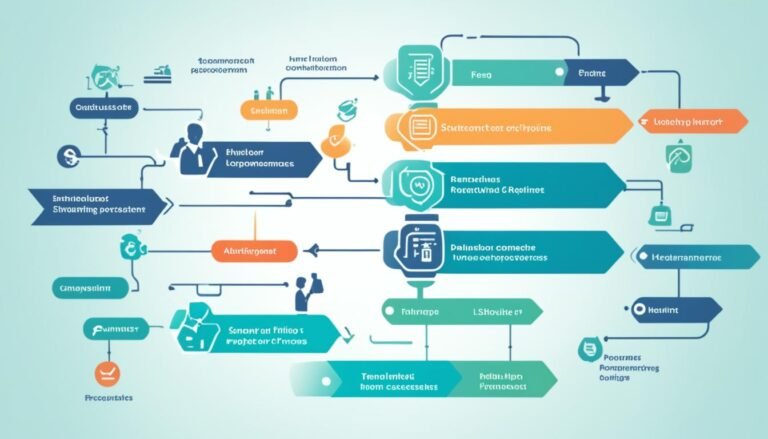A Guide to Human Resource Management Risk Assessment
Human resource management risk assessment is an essential process for organizations to identify and mitigate potential risks related to their workforce. It involves assessing and managing risks in areas such as employee behavior, compliance with labor laws, data privacy and security, and M&A transitions. By implementing a comprehensive HR risk management plan, organizations can proactively address potential issues, ensure legal compliance, and protect their reputation.
Key Takeaways:
- HR risk assessment is crucial for identifying and managing potential risks in areas such as employee behavior, compliance, data security, and M&A transitions.
- A comprehensive HR risk management plan helps organizations address potential issues, ensure legal compliance, and protect their reputation.
- Key HR risk areas include employee turnover, burnout, workplace conflict, harassment, employee engagement, remote work risks, cybersecurity risks, compliance risks, ethical employment practices, talent management risks, and M&A risks.
- HR risk management is important for taking a proactive approach to HR issues, complying with labor laws, and building a productive workforce.
- Creating an HR risk management plan involves steps such as HR audit, risk analysis, risk management techniques, and consultation with experts.
What is HR Risk Management?
HR risk management is a crucial aspect of effectively managing the potential risks associated with the workforce. It involves identifying and addressing risks related to various HR functions, including hiring, retaining, and managing employees, as well as dealing with potential issues regarding employee behavior. By implementing strategic risk management techniques, organizations can proactively manage these risks and minimize their impact.
Organizations can apply a range of risk management techniques to address HR-related risks:
- Avoidance: This technique involves eliminating or avoiding certain risks altogether. Organizations may choose to avoid hiring candidates with a higher risk of turnover or implement policies to prevent workplace behaviors that could lead to legal issues.
- Retention: Retention strategies are used to reduce employee turnover risks. These strategies may include implementing employee engagement initiatives, providing professional development opportunities, and offering competitive benefits and compensation packages.
- Loss prevention and reduction: This technique involves creating policies, procedures, and training programs to minimize the likelihood and impact of potential losses, such as workplace accidents, data breaches, or legal disputes.
- Transfer/sharing: Organizations can transfer or share the risks associated with certain HR functions to external parties, such as outsourcing specific HR responsibilities to third-party vendors or securing insurance coverage to mitigate financial risks.
H3: “Effective HR risk management involves identifying potential risks and implementing measures to minimize their impact on the organization and its employees.” – HR Risk Management Expert
Developing an HR risk management plan is a fundamental step in effectively managing HR risks. It provides organizations with a comprehensive roadmap to identify, assess, prioritize, and mitigate potential risks. This plan may include processes and procedures to ensure compliance with labor laws and regulations, strategies to address employee behavior risks, and guidelines for managing workforce restructuring or M&A transitions.
| Risk Management Processes | Description |
|---|---|
| Risk Identification | Identifying and assessing potential HR risks |
| Risk Analysis | Evaluating the severity and impact of identified risks |
| Risk Mitigation | Implementing strategies and measures to reduce risks |
| Risk Monitoring | Ongoing monitoring and reassessment of HR risks |
Key HR Risk Areas
When it comes to human resource management, there are several key areas that organizations need to pay attention to. Failing to address these areas adequately can lead to various risks and challenges. It is essential for organizations to identify and mitigate these risks to ensure the well-being of their workforce and the success of their business.
1. Employee Turnover
Employee turnover refers to the rate at which employees leave an organization and need to be replaced. High turnover rates can be costly and disruptive to business operations. Organizations should strive to understand the reasons behind turnover and implement strategies to improve employee retention.
2. Employee Burnout
Employee burnout is a state of emotional, mental, and physical exhaustion caused by excessive and prolonged stress. It can lead to decreased productivity, increased absenteeism, and a higher risk of employee turnover. Organizations should prioritize employee well-being and implement policies and practices that support work-life balance and prevent burnout.
3. Workplace Conflict
Workplace conflict can arise due to various factors, such as differences in opinions, communication breakdowns, or interpersonal issues. Unresolved conflicts can negatively impact employee morale, productivity, and organizational culture. It is crucial for organizations to promote effective communication, conflict resolution skills, and foster a positive work environment.
4. Workplace Harassment
Workplace harassment refers to any unwelcome behavior based on an individual’s protected characteristic, such as gender, race, religion, or age, that creates a hostile or intimidating work environment. Organizations should have policies and procedures in place to prevent and address workplace harassment and create a culture of respect and inclusivity.
5. Lack of Employee Engagement
Employee engagement refers to the emotional commitment and dedication employees have towards their work and the organization. A lack of engagement can lead to decreased productivity, higher turnover rates, and poor work quality. Organizations should focus on fostering employee engagement by providing meaningful work, recognition, and opportunities for growth and development.
6. Risks Associated with Remote Work
The shift towards remote work has introduced new risks and challenges for organizations. These include issues related to data security, communication and collaboration, and maintaining employee well-being and productivity in a remote setting. Organizations should establish guidelines, policies, and secure remote work infrastructure to minimize these risks.
7. Cybersecurity Risks
In today’s digital age, organizations face significant risks related to cybersecurity. Unauthorized access to sensitive employee and company data can lead to financial loss, reputational damage, and legal consequences. Organizations should maintain strong cybersecurity measures, such as encryption, network security, and employee training on safe internet practices.
8. HR Compliance Risks
Non-compliance with labor laws and regulations can result in financial penalties, legal disputes, and damage to an organization’s reputation. It is crucial for organizations to stay updated on relevant laws and regulations, implement compliance measures, and conduct regular audits to ensure adherence to HR compliance requirements.
9. Ethical Employment Practices
Organizations are expected to uphold ethical employment practices, such as fair treatment, equal opportunities, and respect for employee rights. Failing to meet ethical standards can harm employee morale, attract negative publicity, and lead to legal consequences. Organizations must prioritize ethical practices throughout the employee lifecycle.
10. Talent Management Risks
Effective talent management encompasses attracting, developing, and retaining skilled employees to meet organizational goals. Risks in talent management include ineffective recruitment and selection processes, inadequate employee development programs, and a lack of succession planning. Organizations should implement robust talent management strategies to mitigate these risks and ensure the availability of a skilled workforce.
11. Risks Related to Mergers and Acquisitions
Mergers and acquisitions involve integration challenges, such as cultural differences, employee resistance, communication gaps, and talent retention issues. Organizations should conduct thorough due diligence, develop integration plans, and provide support to employees throughout the process to mitigate these risks and maximize the chances of a successful merger or acquisition.
Understanding and addressing these key HR risk areas will enable organizations to proactively manage potential risks, create a safe and productive work environment, and enhance the overall success of their talent management strategies.
Why is HR Risk Management Important?
HR risk management plays a crucial role in organizations for various reasons:
- Proactive approach to HR issues: Organizations that implement effective HR risk management strategies can address potential issues proactively. By identifying and resolving HR risks before they escalate, organizations can prevent major challenges and maintain a harmonious work environment.
- Compliance with labor laws: HR risk management ensures that organizations remain compliant with labor laws and regulations. By addressing HR risks related to employment practices, workplace safety, and data privacy, organizations can minimize legal threats and potential fines.
- Protection of organizational reputation: By effectively managing HR risks, organizations can protect their reputation. Addressing issues such as workplace conflict, harassment, or non-compliance with ethical employment practices demonstrates a commitment to fostering a respectful, inclusive, and compliant work environment.
- Building a productive workforce: HR risk management contributes to building a productive workforce. By mitigating risks associated with employee turnover, burnout, or disengagement, organizations can create a positive work environment that enhances employee satisfaction, retention, and performance.
“Effective HR risk management is essential for organizations to proactively address potential issues, ensure compliance, protect their reputation, and build a productive workforce.”
Implementing HR risk management strategies is crucial for organizations aiming to stay ahead in an increasingly complex business landscape. By focusing on proactive risk mitigation, compliance, reputation protection, and employee satisfaction, organizations can create a sustainable and successful work environment.
Creating an HR Risk Management Plan
Creating an effective HR risk management plan is crucial for organizations looking to proactively address potential risks and protect their workforce. This involves a systematic approach that includes steps for HR risk assessment, risk analysis and ranking, and the implementation of appropriate risk management techniques.
Step 1: HR Audit and Assessment
The first step in creating an HR risk management plan is to conduct a thorough HR audit and assessment. This involves evaluating the organization’s current HR practices, policies, and procedures to identify areas that may pose risks. The HR audit should consider factors such as compliance with labor laws, workplace safety measures, and employee behavior.
Step 2: Risk Analysis and Ranking
Once the HR audit is complete, the next step is to analyze and rank each identified HR risk. This involves evaluating the probability of each risk occurring, the preventability of the risk, the severity of its consequences, and its potential impact on organizational goals. By assigning a ranking to each risk, organizations can prioritize their efforts and allocate appropriate resources for risk management.
Step 3: Risk Management Techniques
After ranking the HR risks, organizations must develop strategies and implement risk management techniques to minimize their impact. Some common risk management techniques in HR include:
- Comprehensive Candidate Vetting: Thoroughly screen and evaluate job candidates to ensure they are a good fit for the organization and have a lower risk of misconduct or poor performance.
- Robust Onboarding and Training Programs: Implement comprehensive onboarding and training programs to equip employees with the necessary skills and knowledge to perform their roles effectively and adhere to organizational policies.
- Strong Cybersecurity Measures: Implement robust cybersecurity measures to protect employee and organizational data from potential breaches and cyber attacks.
- Compliance Monitoring: Regularly monitor and review compliance with labor laws, regulations, and internal policies to ensure adherence and identify any potential areas of non-compliance.
- Consultation with Experts or Employment Attorneys: Seek guidance from HR experts or employment attorneys to address complex HR risks and legal issues effectively.
By applying these risk management techniques, organizations can mitigate HR risks and create a safer and more productive work environment.
| Risk Management Techniques in HR | Description |
|---|---|
| Comprehensive Candidate Vetting | Thoroughly screening and evaluating job candidates to minimize the risk of misconduct or poor performance in the organization. |
| Robust Onboarding and Training Programs | Implementing comprehensive programs to equip employees with the necessary skills and knowledge for their roles, and to ensure adherence to organizational policies. |
| Strong Cybersecurity Measures | Implementing robust measures to safeguard employee and organizational data from potential cyber attacks or breaches. |
| Compliance Monitoring | Regularly monitoring and reviewing compliance with labor laws, regulations, and internal policies to ensure adherence and identify areas of non-compliance. |
| Consultation with Experts or Employment Attorneys | Seeking guidance from HR experts or employment attorneys to effectively address complex HR risks and legal issues. |
A properly executed HR risk management plan can significantly reduce the likelihood of HR-related incidents, protect the organization’s reputation, and ensure a more productive and engaged workforce.
Types of HR Risks
There are several types of HR risks that organizations need to be aware of. These risks can have significant impacts on the overall functioning and success of a company. Understanding the different types of HR risks can help organizations identify potential vulnerabilities and take proactive measures to mitigate them. The key types of HR risks include:
1. Recruitment Risks
Recruitment risks pertain to challenges and uncertainties associated with the hiring process. Ineffective hiring procedures can lead to a mismatch between the organization’s needs and the skills or qualifications of the hired candidates. Discriminatory hiring decisions can also expose the organization to legal liabilities. Implementing robust recruitment strategies, conducting thorough candidate assessments, and ensuring a diverse and inclusive hiring process are essential for mitigating recruitment risks.
2. Retention Risks
Retention risks refer to factors that may contribute to high employee turnover rates or difficulty in retaining top talent. Insufficient employee engagement, inadequate onboarding or training programs, lack of career development opportunities, and poor organizational culture can all have detrimental effects on employee retention. Organizations must prioritize employee engagement initiatives, provide comprehensive onboarding and training programs, and create a positive work environment to mitigate retention risks.
3. Compliance Risks
Compliance risks involve the potential violations of labor laws, workplace safety regulations, and other legal obligations. Non-compliance can result in legal consequences, penalties, and reputational damage. Organizations must stay up to date with labor laws, implement robust compliance monitoring mechanisms, and establish clear policies and procedures to ensure adherence to legal requirements and mitigate compliance risks.
4. Employment Risks
Employment risks encompass various challenges associated with managing employee behavior and maintaining a harmonious work environment. These risks may include workplace conflict, harassment, discrimination, or issues related to ethics and employment practices. Implementing robust HR policies and procedures, providing comprehensive employee training, and fostering a culture of respect and inclusivity are crucial for mitigating employment risks.
5. Data Privacy and Security Risks
Data privacy and security risks are becoming increasingly prevalent in the digital era. Organizations must safeguard sensitive employee and customer data from cybersecurity breaches, unauthorized access, or mishandling. Implementing robust cybersecurity measures, conducting regular data privacy assessments, and providing appropriate training to employees on data protection practices are essential for mitigating data privacy and security risks.
Understanding and addressing the various types of HR risks is crucial for organizations to ensure a productive and compliant work environment. By implementing effective risk mitigation strategies tailored to each type of risk, organizations can protect their employees, reputation, and overall business operations.
Techniques for Mitigating HR Risks
Organizations can implement various techniques to effectively mitigate HR risks and protect their workforce. By implementing these techniques, organizations can minimize the occurrence and impact of HR risks, ensuring a safe and secure work environment. Some of the key techniques for HR risk mitigation include:
1. Developing Comprehensive HR Policies and Procedures
HR policies and procedures provide guidelines and instructions for employees and management to follow, ensuring consistency and compliance with relevant laws and regulations. These policies cover areas such as employee conduct, anti-discrimination, performance evaluation, and disciplinary actions.
2. Providing Training and Education Opportunities
Investing in training and education programs helps employees develop the necessary skills and knowledge to perform their roles effectively. Training programs can cover areas such as workplace safety, compliance, diversity and inclusion, and conflict resolution. By enhancing employee knowledge and awareness, organizations can minimize risks associated with inadequate training and understanding of policies and procedures.
3. Implementing a Strong Onboarding Process
A strong onboarding process plays a crucial role in setting employees up for success. It involves providing new hires with a comprehensive orientation, introducing them to the organization’s culture, policies, and procedures, and ensuring they have the resources they need to thrive in their roles. By establishing a solid foundation from the beginning, organizations can reduce risks associated with employee turnover, poor performance, and lack of engagement.
4. Utilizing Risk Management Software
Risk management software provides organizations with a centralized platform to monitor and manage regulatory compliance, identify potential risks, and implement appropriate controls. This software helps streamline processes, automate compliance checks, and generate reports for analysis and decision-making. By leveraging technology, organizations can enhance their risk management capabilities and ensure proactive risk mitigation.
“By implementing a proactive approach to HR risk management, organizations can protect their employees, minimize legal risks, and foster a productive and compliant work environment.”
Implementing these HR risk mitigation techniques helps organizations build a strong foundation for managing HR risks effectively. By developing comprehensive policies and procedures, investing in employee training and education, implementing a strong onboarding process, and utilizing risk management software, organizations can proactively identify and address potential HR risks, ensuring the well-being of their workforce and the long-term success of the organization.
| Technique | Description |
|---|---|
| Developing Comprehensive HR Policies and Procedures | Establishing guidelines and instructions to ensure consistency and compliance with laws and regulations. |
| Providing Training and Education Opportunities | Investing in employee development through relevant training programs to enhance skills and knowledge. |
| Implementing a Strong Onboarding Process | Creating a comprehensive orientation to introduce new hires to the organization’s culture and expectations. |
| Utilizing Risk Management Software | Using software to monitor compliance, identify risks, and implement appropriate controls. |
Benefits of HR Risk Management
Implementing effective HR risk management has numerous benefits for organizations. By prioritizing risk management efforts in human resources, organizations can reap the following advantages:
- Improved Engagement: HR risk management ensures compliance with regulations and fosters a safe and secure work environment, leading to higher employee engagement levels.
- Increased Employee Satisfaction and Retention: Proactive risk mitigation minimizes potential risks and incidents, resulting in higher employee satisfaction and improved retention rates.
- Reduction in Costs: Avoiding fines, litigation, and other legal issues associated with HR risks can lead to significant cost savings in the long run.
- Better Organizational Performance: By minimizing the time and resources spent on addressing HR-related problems, effective risk management enhances overall organizational performance.
Organizations that prioritize HR risk management can create a more positive workplace culture, ensure legal compliance, and protect their bottom line.
“Implementing effective HR risk management ensures compliance with regulations, fosters a safe and secure work environment, and leads to higher employee engagement levels.”
Conducting a Risk Assessment for Employees
A risk assessment for employees is a crucial process that involves analyzing and managing risks associated with employee behavior, workplace behavior, compliance with employment laws, and workplace safety regulations. By conducting a thorough risk assessment, organizations can identify potential risks and develop effective strategies to prevent or mitigate them, ensuring a safe and productive work environment.
Conducting a risk assessment requires the expertise of a competent person or team with knowledge and experience in assessing workplace risks. This individual or team should have a deep understanding of employee behavior, workplace dynamics, and relevant employment laws and safety regulations.
The risk assessment process typically involves the following steps:
- Identifying Hazards: The first step is to identify potential hazards or risks that may exist in the workplace. This includes considering factors such as physical hazards, hazardous substances, workplace conditions, and employee behavior.
- Assessing Risks: Once the hazards are identified, the next step is to assess the risks associated with each hazard. This involves evaluating the likelihood of the risk occurring and the potential consequences if it does.
- Implementing Control Measures: After assessing the risks, control measures need to be implemented to minimize or eliminate the identified risks. This may involve implementing safety protocols, providing appropriate training and education, and adopting workplace policies and procedures.
By conducting a comprehensive risk assessment for employees, organizations can proactively address potential risks and ensure compliance with employment laws and workplace safety regulations. It enables them to create a safe and healthy work environment for their employees, reducing the likelihood of accidents, conflicts, and legal issues.
“The safety of our employees is our top priority. By conducting regular risk assessments, we are able to identify and address potential risks, ensuring a safe and productive workplace for everyone.”
Image:
Legal Requirements and Importance of Risk Assessments
Conducting risk assessments is a legal requirement for organizations, regardless of their size. These assessments play a crucial role in ensuring workplace health and safety and ensuring compliance with labor laws and regulations. By conducting comprehensive risk assessments, organizations can identify potential hazards and risks that may impact their employees and operations.
The importance of risk assessments extends beyond mere compliance. Risk assessments provide organizations with valuable insights into potential workplace hazards and help them develop appropriate control measures. By implementing these control measures, organizations can prevent or reduce the likelihood of workplace injuries or legal issues, protecting both their employees and their reputation.
Compliance with regulations and laws is a critical aspect of risk assessment. Organizations must stay up to date with legal and regulatory requirements to avoid fines, lawsuits, and reputational damage. Failure to comply with the legal requirements can have severe consequences and adversely affect the organization’s bottom line.
Risk assessments also contribute to a positive work environment by instilling a culture of safety and accountability. Employees feel valued and protected when organizations prioritize risk assessment and take proactive measures to address potential risks. This, in turn, leads to increased employee satisfaction, productivity, and overall organizational success.
“Risk assessments are an indispensable tool that organizations should embrace to create a safe and compliant workplace. By fulfilling legal requirements and proactively identifying and managing risks, organizations can protect their employees, ensure regulatory compliance, and maintain their reputation.”
Benefits of Conducting Risk Assessments
| Benefits | Description |
|---|---|
| Ensuring legal compliance | By identifying and addressing potential risks, organizations can comply with relevant laws and regulations, preventing legal issues and costly penalties. |
| Enhancing workplace safety | Risk assessments help organizations identify potential hazards and develop effective control measures to minimize workplace injuries and accidents. |
| Protecting employee well-being | Through risk assessments, organizations can identify risks that may impact employee health, allowing them to implement preventive measures and promote a healthy work environment. |
| Safeguarding organizational reputation | Proactive risk assessments enable organizations to address potential risks before they escalate, protecting their reputation and maintaining the trust of stakeholders. |
| Increasing operational efficiency | By minimizing risks and addressing potential issues, organizations can optimize their operations, improving resource allocation and overall efficiency. |
Conclusion
In conclusion, HR risk assessment and management play a crucial role in helping organizations identify and address potential risks associated with their workforce. By conducting comprehensive risk assessments, organizations can develop effective strategies and implement measures to protect their employees and ensure compliance with labor laws. Additionally, HR risk management is essential for safeguarding the organization’s reputation and maintaining a safe and productive work environment.
HR risk management is an ongoing process that requires regular assessment and monitoring to adapt to changing risks. By staying proactive and vigilant, organizations can minimize the impact of potential risks, reduce costs, and enhance overall organizational performance. Moreover, HR risk management enables organizations to create a positive work culture, boost employee engagement, satisfaction, and retention, and mitigate legal threats and fines. It is a critical component of strategic workforce management.
To effectively manage HR risks, organizations should consider implementing techniques such as developing robust HR policies and procedures, providing regular training and education opportunities for employees, and implementing risk management software. By integrating these practices into their HR risk management plan, organizations can create a resilient and proactive framework for addressing HR risks and ensure the long-term success of their workforce.







